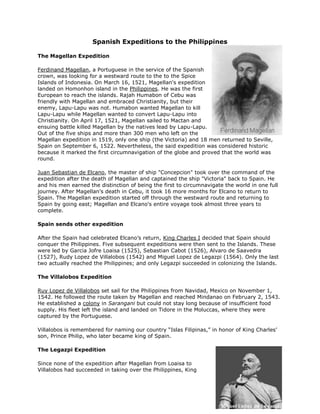
Spanish expeditions to the philippines
- 1. Spanish Expeditions to the Philippines<br />right0The Magellan Expedition<br /> HYPERLINK quot; http://www.studyworld.com/ferdinand_magellan.htmquot; Ferdinand Magellan, a Portuguese in the service of the Spanish crown, was looking for a westward route to the to the Spice Islands of Indonesia. On March 16, 1521, Magellan's expedition landed on Homonhon island in the HYPERLINK quot; http://www.philippine-history.org/about-philippines.htmquot; Philippines. He was the first European to reach the islands. Rajah Humabon of Cebu was friendly with Magellan and embraced Christianity, but their enemy, Lapu-Lapu was not. Humabon wanted Magellan to kill Lapu-Lapu while Magellan wanted to convert Lapu-Lapu into Christianity. On April 17, 1521, Magellan sailed to Mactan and ensuing battle killed Magellan by the natives lead by Lapu-Lapu. Out of the five ships and more than 300 men who left on the Magellan expedition in 1519, only one ship (the Victoria) and 18 men returned to Seville, Spain on September 6, 1522. Nevertheless, the said expedition was considered historic because it marked the first circumnavigation of the globe and proved that the world was round.<br /> HYPERLINK quot; http://en.wikipedia.org/wiki/Juan_Sebastian_Elcanoquot; Juan Sebastian de Elcano, the master of ship quot; Concepcionquot; took over the command of the expedition after the death of Magellan and captained the ship quot; Victoriaquot; back to Spain. He and his men earned the distinction of being the first to circumnavigate the world in one full journey. After Magellan's death in Cebu, it took 16 more months for Elcano to return to Spain. The Magellan expedition started off through the westward route and returning to Spain by going east; Magellan and Elcano's entire voyage took almost three years to complete.<br />Spain sends other expedition<br />After the Spain had celebrated Elcano’s return, HYPERLINK quot; http://library.thinkquest.org/6196/rulers.htmlquot; King Charles I decided that Spain should conquer the Philippines. Five subsequent expeditions were then sent to the Islands. These were led by Garcia Jofre Loaisa (1525), Sebastian Cabot (1526), Alvaro de Saavedra (1527), Rudy Lopez de Villalobos (1542) and Miguel Lopez de Legazpi (1564). Only the last two actually reached the Philippines; and only Legazpi succeeded in colonizing the Islands.<br />The Villalobos Expedition<br /> HYPERLINK quot; http://www.answers.com/topic/ruy-l-pez-de-villalobosquot; Ruy Lopez de Villalobos set sail for the Philippines from Navidad, Mexico on November 1, 1542. He followed the route taken by Magellan and reached Mindanao on February 2, 1543. He established a HYPERLINK quot; http://www.philippine-history.org/spanish-colonial-masters.htmquot; colony in Sarangani but could not stay long because of insufficient food supply. His fleet left the island and landed on Tidore in the Moluccas, where they were captured by the Portuguese.<br />Villalobos is remembered for naming our country “Islas Filipinas,” in honor of King Charles’ son, Prince Philip, who later became king of Spain.<br />right0The Legazpi Expedition<br />Since none of the expedition after Magellan from Loaisa to Villalobos had succeeded in taking over the Philippines, King Charles I stopped sending colonizers to the Islands. However, when Philip II succeeded his father to the throne in 1556, he instructed Luis de Velasco, the viceroy of Mexico, to prepare a new expedition – to be headed by Miguel Lopez de Legazpi, who would be accompanied by HYPERLINK quot; http://en.wikipedia.org/wiki/Andres_de_Urdanetaquot; Andres de Urdaneta, a priest who had survived the Loaisa mission.<br />On February 13, 1565, Legaspi's expedition landed in Cebu island. After a short struggle with the natives, he proceeded to Leyte, then to Camiguin and to Bohol. There Legaspi made a blood compact with the chieftain, Datu Sikatuna as a sign of friendship. Legaspi was able to obtain spices and gold in Bohol due to his friendship with Sikatuna. On April 27, 1565, Legaspi returned to Cebu; destroyed the town of Raja Tupas and establish a settlement. On orders of the King Philip II, 2,100 men arrived from Mexico. They built the the port of Fuerza de San Pedro which became the Spanish trading outpost and stronghold for the region.<br />Hearing of the riches of HYPERLINK quot; http://www.manila.gov.ph/quot; Manila, an expedition of 300 men headed by HYPERLINK quot; http://www.findagrave.com/cgi-bin/fg.cgi?page=gr&GRid=14119268quot; Martin de Goiti left Cebu for Manila. They found the islands of Panay and Mindoro. Goiti arrived in Manila on May 8, 1570. At first they were welcomed by the natives and formed an alliance with Rajah Suliman, their Muslim king but as the locals sensed the true objectives of the Spaniards, a battle between the troops of Suliman and the Spaniards erupted. Because the Spaniards are more heavily armed, the Spaniards were able to conquer Manila. Soon after Miguel Lopez de Legazpi arrived to join Goiti in Manila. Legaspi built alliances and made peace with Rajahs Suliman, Lakandula and Matanda. In 1571, Legaspi ordered the construction of the walled city of Intramuros and proclaimed it as the seat of government of the HYPERLINK quot; http://www.philippine-history.org/spanish-colonial-masters.htmquot; colony and the capital of the islands. In 1572, Legaspi died and was buried at the San Agustin Church in Intramuros. In 1574, Manila was bestowed the title quot; Insigne y Siempre Leal Ciudad de Españaquot; (Distinguished and ever loyal city of Spain) by HYPERLINK quot; http://en.wikipedia.org/wiki/Philip_II_of_Spainquot; King Philip II of Spain.<br />Why the Philippines was easily conquered<br />Through largely outnumbered, the Spaniards who came to colonize the Philippines easily took control of our country. How did this happen?<br /> <br />The best possible explanation is that the natives lacked unity and a centralized form of government. Although the barangays already functioned as units of governance, each one existed independently of the other, and the powers that each Datu enjoyed were confined only to his own barangay. No higher institution united the barangays, and the Spaniards took advantage of this situation. They used the barangays that were friendly to them in order to subdue the barangays that were not.<br />
